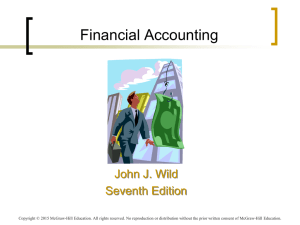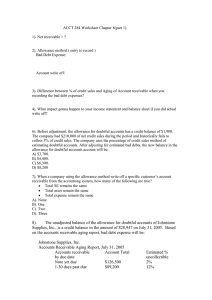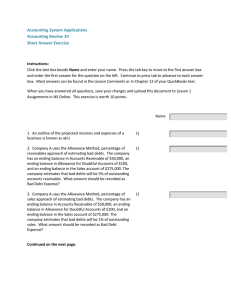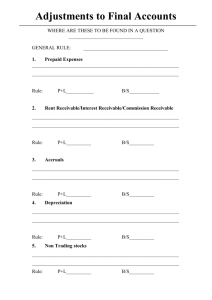CHAPTER 8 WHEN REVENUE IS RECOGNIZED
advertisement
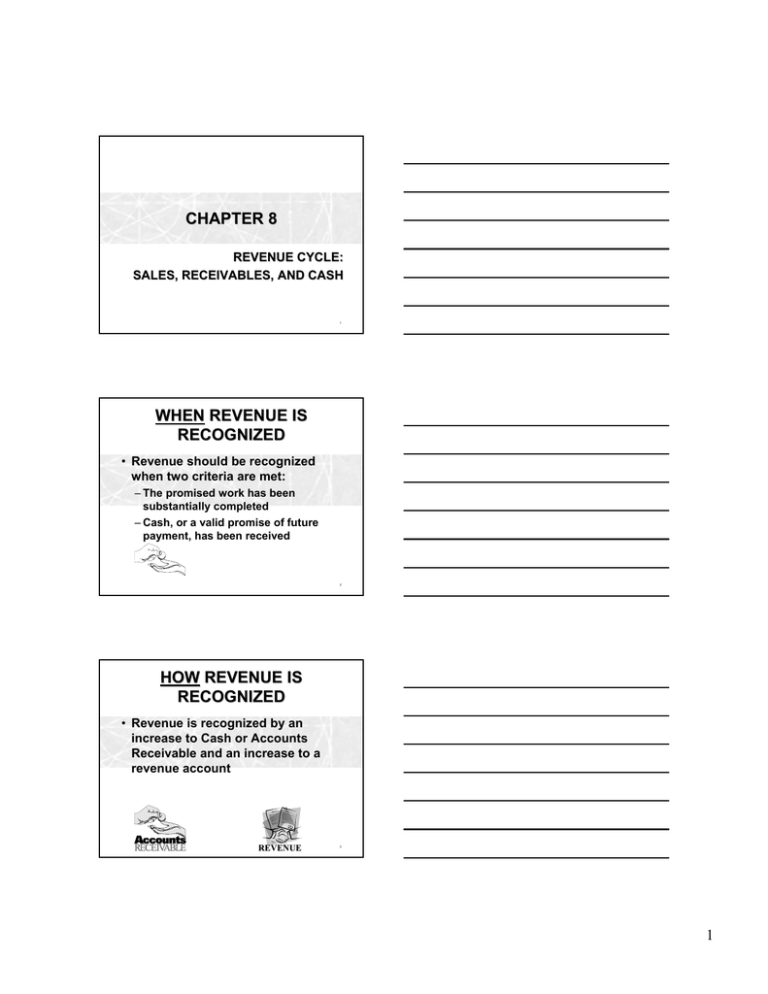
CHAPTER 8 REVENUE CYCLE: SALES, RECEIVABLES, AND CASH 1 WHEN REVENUE IS RECOGNIZED • Revenue should be recognized when two criteria are met: – The promised work has been substantially completed – Cash, or a valid promise of future payment, has been received 2 HOW REVENUE IS RECOGNIZED • Revenue is recognized by an increase to Cash or Accounts Receivable and an increase to a revenue account REVENUE 3 1 SELLING ON CREDIT AND COLLECTING CASH • The primary costs associated with selling on credit are – Bad debts – Bookkeeping costs • Billing system • Processing collections – Carrying costs • The opportunity cost of not making a return on the cash tied up in the form of accounts receivable 4 CREDIT POLICIES • The credit period determines when the cash will be collected – n/30, read “net thirty,” means that payment is due within 30 days from the date of the invoice • Sales discounts are cash reductions offered to credit customers who pay their bills early 5 ACCOUNTING FOR CREDIT CUSTOMERS WHO DON’ DON’T PAY • Bad debt expense is a natural consequence of selling merchandise on credit • The matching concept requires that new bad debts be estimated and reported in the same year that the sales occur • This estimation method is known as the allowance method 6 2 ACCOUNTING FOR CREDIT CUSTOMERS WHO DON’ DON’T PAY • The allowance method uses one of two estimation procedures: – Percentage of sales method – Aging method • Under either method an increase to Bad Debts Expense is recorded, along with a corresponding increase to Allowance for Bad Debts (a contra account to Accounts Receivable) 7 PERCENTAGE OF SALES METHOD • Under this method, an estimate of bad debts expense is made by multiplying a percentage (based on past experience) times credit sales 8 PERCENTAGE OF SALES METHOD • If Sales are $200,000 and historically 3% of credit sales have become uncollectible, the following year-end entry would be made: Bad Debts Expense 6,000 Allowance for Bad Debts 6,000 9 3 THE AGING METHOD • The aging method involves dividing the Accounts Receivable balance into different age categories to estimate the amount of those accounts which will ultimately become uncollectible • This balance sheet approach seeks to estimate an appropriate year-end balance for the Allowance for Bad Debts account 10 THE AGING METHOD • The chances that an account will ultimately be uncollectible increase as the account gets older • Assume the following aging analysis for Accounts Receivable: Age of Account Less than 30 days 31 to 60 days Aged Balance $27,600 5,800 61 to 90 days 3,100 Over 90 days Total 3,500 $40,000 11 THE AGING METHOD • Assigning percentages to each age category yields the following results: % Ultimately Age of Account Uncollectible Less than 30 days 4% Aged Balance $27,600 Required Allowance Amount $1,104 31 to 60 days 20% 5,800 61 to 90 days 40% 3,100 1,240 Over 90 days 80% 3,500 2,800 $40,000 $6,304 Total 1,160 12 4 THE AGING METHOD • The year-end entry would be for an amount that would result in an Allowance for Bad Debts balance of $6,304 13 WRITEWRITE-OFFS OF BAD DEBTS • When a specific account is determined to be uncollectible, both the Accounts Receivable and the allowance account are reduced • The journal entry for writing off an uncollectible account with a $3,200 balance would be Allowance for Bad Debts 3,200 Accounts Receivable 3,200 14 THE ALLOWANCE FOR BAD DEBTS TT-ACCOUNT • The following T-account depicts the events that affect the allowance account Allowance for Bad Debts Subtract: WriteWrite-Offs Beginning Balance Add: Estimated Bad Debts Ending Balance 15 5 ACCOUNTING FOR WARRANTIES • Like bad debts expense, warranty expense must be estimated and recognized in the same period in which the revenue is recognized • The accountant must estimate the expense before all of the facts are in Warranty 16 ACCOUNTING FOR WARRANTIES The year-end entry to record Veda Landscape’ Landscape’s estimated Shrub Warranty Expense from planting 50 shrubs is Shrub Warranty Expense 175 Estimated Liability for Service 175 17 ACCOUNTING FOR WARRANTIES The entry to record actual warranty costs of replacing shrubs is Estimated Liability for Service 145 Cash (for employee labor) 100 Supplies (for replacment shrubs) 45 18 6 THE ESTIMATED LIABILITY FOR SERVICE TT-ACCOUNT The following T-account depicts the events that affect the estimated liability account: Estimated Liability for Service Actual Cost Incurred 145 Estimate At Time of Sale 175 Remaining Balance 30 19 CASH MANAGEMENT • Two methods of obtaining cash from receivables without waiting for collection from customers: – Assignment of receivables • Specific receivables are used as collateral for a loan • Disclosure in the financial statement notes is required – Factoring 20 CASH MANAGEMENT • Factoring involves one company selling some of its receivables to another company (the factor) who charges a fee for the service • Receivables are usually sold “without recourse” – The factor assumes all the risk of collecting the receivables 21 7 MANAGING THE QUANTITY OF ACCOUNTS RECEIVABLE • The accounts receivable turnover determines how many times during the year a company is collecting its average receivable balance Accounts Receivable = Turnover Sales Average Accounts Receivable 22 MANAGING THE QUANTITY OF ACCOUNTS RECEIVABLE • The accounts receivable turnover can be converted into the average collection period • The lower the average collection period, the more favorable the ratio Average Collection = Period 365 Accounts Receivable Turnover 23 8
